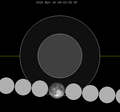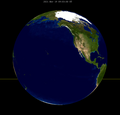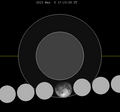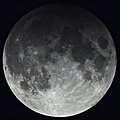May 2023 lunar eclipse
| Penumbral eclipse | |||||||||
 | |||||||||
| Date | May 5, 2023 | ||||||||
|---|---|---|---|---|---|---|---|---|---|
| Gamma | −1.0349 | ||||||||
| Magnitude | −0.0438 | ||||||||
| Saros cycle | 141 (24 of 73) | ||||||||
| Penumbral | 257 minutes, 31 seconds | ||||||||
| |||||||||
A penumbral lunar eclipse occurred at the Moon’s descending node of orbit on Friday, May 5, 2023,[1] with an umbral magnitude of −0.0438. A lunar eclipse occurs when the Moon moves into the Earth's shadow, causing the Moon to be darkened. A penumbral lunar eclipse occurs when part or all of the Moon's near side passes into the Earth's penumbra. Unlike a solar eclipse, which can only be viewed from a relatively small area of the world, a lunar eclipse may be viewed from anywhere on the night side of Earth. Occurring about 5.2 days before perigee (on May 11, 2023, at 1:05 UTC), the Moon's apparent diameter was larger.[2]
This was the deepest penumbral eclipse (with –0.0438 magnitude) since February 2017 and until September 2042.[3]
Visibility
[edit]The eclipse was completely visible over Asia, Australia, and Antarctica, seen rising over Africa and Europe and setting over the central Pacific Ocean.[4]
 
|
 Visibility map |
Gallery
[edit]-
Perth, Australia, 16:48 UTC
-
Astronomical telescope view from Kuching, Malaysia, 17:26 UTC
-
Moscow, Russia, 17:49 UTC
-
Moonrise and moon track during eclipse in Moscow, 17:56 UTC
-
Penumbral eclipse of 5 May 2023 taken from Oria, Italy at 18:17 UTC
Eclipse details
[edit]Shown below is a table displaying details about this particular solar eclipse. It describes various parameters pertaining to this eclipse.[5]
| Parameter | Value |
|---|---|
| Penumbral Magnitude | 0.96551 |
| Umbral Magnitude | −0.04378 |
| Gamma | −1.03495 |
| Sun Right Ascension | 02h49m59.7s |
| Sun Declination | +16°19'27.9" |
| Sun Semi-Diameter | 15'51.6" |
| Sun Equatorial Horizontal Parallax | 08.7" |
| Moon Right Ascension | 14h48m23.5s |
| Moon Declination | -17°14'31.7" |
| Moon Semi-Diameter | 15'42.8" |
| Moon Equatorial Horizontal Parallax | 0°57'40.1" |
| ΔT | 70.9 s |
Eclipse season
[edit]This eclipse is part of an eclipse season, a period, roughly every six months, when eclipses occur. Only two (or occasionally three) eclipse seasons occur each year, and each season lasts about 35 days and repeats just short of six months (173 days) later; thus two full eclipse seasons always occur each year. Either two or three eclipses happen each eclipse season. In the sequence below, each eclipse is separated by a fortnight.
| April 20 Ascending node (new moon) |
May 5 Descending node (full moon) |
|---|---|
 |

|
| Hybrid solar eclipse Solar Saros 129 |
Penumbral lunar eclipse Lunar Saros 141 |
Related eclipses
[edit]Eclipses in 2023
[edit]- A hybrid solar eclipse on April 20.
- A penumbral lunar eclipse on May 5.
- An annular solar eclipse on October 14.
- A partial lunar eclipse on October 28.
Metonic
[edit]- Preceded by: Lunar eclipse of July 16, 2019
- Followed by: Lunar eclipse of February 20, 2027
Tzolkinex
[edit]- Preceded by: Lunar eclipse of March 23, 2016
- Followed by: Lunar eclipse of June 15, 2030
Half-Saros
[edit]- Preceded by: Solar eclipse of April 29, 2014
- Followed by: Solar eclipse of May 9, 2032
Tritos
[edit]- Preceded by: Lunar eclipse of June 4, 2012
- Followed by: Lunar eclipse of April 3, 2034
Lunar Saros 141
[edit]- Preceded by: Lunar eclipse of April 24, 2005
- Followed by: Lunar eclipse of May 16, 2041
Inex
[edit]- Preceded by: Lunar eclipse of May 25, 1994
- Followed by: Lunar eclipse of April 14, 2052
Triad
[edit]- Preceded by: Lunar eclipse of July 4, 1936
- Followed by: Lunar eclipse of March 6, 2110
Lunar eclipses of 2020–2023
[edit]| Lunar eclipse series sets from 2020–2023 | ||||||||
|---|---|---|---|---|---|---|---|---|
| Descending node | Ascending node | |||||||
| Saros | Date | Type Viewing |
Gamma | Saros | Date Viewing |
Type Chart |
Gamma | |
111
|
2020 Jun 05
|
Penumbral
|
1.24063 | 116
|
2020 Nov 30
|
Penumbral
|
−1.13094 | |
121
|
2021 May 26
|
Total
|
0.47741 | 126
|
2021 Nov 19
|
Partial
|
−0.45525 | |
131
|
2022 May 16
|
Total
|
−0.25324 | 136
|
2022 Nov 08
|
Total
|
0.25703 | |
141
|
2023 May 05
|
Penumbral
|
−1.03495 | 146
|
2023 Oct 28
|
Partial
|
0.94716 | |
| Last set | 2020 Jul 05 | Last set | 2020 Jan 10 | |||||
| Next set | 2024 Mar 25 | Next set | 2024 Sep 18 | |||||
Metonic series
[edit]This eclipse is the last of four Metonic cycle lunar eclipses on the same date, 4–5 May, each separated by 19 years:
The metonic cycle repeats nearly exactly every 19 years and represents a Saros cycle plus one lunar year. Because it occurs on the same calendar date, the Earth's shadow will in nearly the same location relative to the background stars.
| Metonic events: May 4 and October 28 | |
|---|---|
| Descending node | Ascending node |
|
|

|

|
Half-Saros cycle
[edit]A lunar eclipse will be preceded and followed by solar eclipses by 9 years and 5.5 days (a half saros).[6] This lunar eclipse is related to two annular solar eclipses of Solar Saros 148.
| April 29, 2014 | May 9, 2032 |
|---|---|

|

|
See also
[edit]References
[edit]- ^ "May 5–6, 2023 Penumbral Lunar Eclipse". timeanddate. Retrieved 18 November 2024.
- ^ "Moon Distances for London, United Kingdom, England". timeanddate. Retrieved 18 November 2024.
- ^ "Penumbral Lunar Eclipse on May 5–6, 2023 – Where and when to See".
- ^ "Penumbral Lunar Eclipse of 2023 May 05" (PDF). NASA. Retrieved 18 November 2024.
- ^ "Penumbral Lunar Eclipse of 2023 May 05". EclipseWise.com. Retrieved 18 November 2024.
- ^ Mathematical Astronomy Morsels, Jean Meeus, p.110, Chapter 18, The half-saros
External links
[edit]- cycle 141
- 2023 May 05 chart: Eclipse Predictions by Fred Espenak, NASA/GSFC






